Shep Hyken's Blog, page 98
September 28, 2020
5 Top Customer Service Articles For the Week of September 28, 2020
Each week I read a number of customer service and customer experience articles from various resources. Here are my top five picks from last week. I have added my comment about each article and would like to hear what you think too.
CX50 2020: Great customer experience starts with company culture by Morag Cuddeford-Jones
(MarketingWeek) At our exclusive roundtable featuring members of 2020’s CX50, the consensus was that taking care of employees has helped take care of customers in this time of crisis.
My Comment: If you’ve been following this weekly roundup, then you know I’m a big fan of focusing on culture when it comes to customer service and CX. The best companies to do business with are also great companies to work for. So, we start this week’s roundup with an article on culture that drives the CX. And, this is especially important during times of crisis.
New Study Finds 3 Top Priorities For CX Leaders by Brian Stucki
(Forbes) In a study led by IDC’s Alan Webber, Program Vice President for Customer Experience, and commissioned by Qualtrics, we uncovered three common themes in what CX leaders at companies with more than 500 employees are prioritizing in their programs.
My Comment: Since the pandemic began, NPS and CSAT scores have dropped – in some cases dramatically. What are CX leaders now focused on? Three main areas that include investing and/or using the right technology, having competent people, and building out the customer-focused culture.
Level-up Your Customer Service With These 4 Dynamite Strategies by Tom Sagi
(The Next Web) No matter what kind of business you run, a huge part of your business’ success ties back to your customer service strategy; according to a 2017 Microsoft report, more than half of consumers have stopped doing business with a company due to poor customer service. And as industries continue to get more and more competitive, building a dedication to customer service into your brand DNA is more important than ever.
My Comment: This article includes four strategies to improve customer service. I’m in agreement with three of the four. You’ll have to decide if having local versus outsourced people is good or bad for you. I can argue both sides. But, I really like number one, which is to keep it simple – as inconvenient. (As simple as that sounds, that doesn’t mean it’s easy!) Read on to learn about numbers two and three.
The Importance of Context in Customer Service by Jeremy Watkin
(CustomerThink) In our contact center, context is a major point of emphasis. Here are some of the ways we gain context on a regular basis.
My Comment: I always enjoy articles from Jeremy Watkin. He’s “in the trenches,” and running customer support centers. In this article, he writes about context. Understanding the context behind the customers’ problems or questions can put you in an even better position to deliver an excellent experience.
How Customer Experience Drives Business Growth by Dildeep Singh
(Business2Community) People place less value on uniqueness and personalization than you may think. Every consumer is looking for four things in the ultimate user experience – speed, convenience, knowledge, and friendly service. They are also willing to pay a premium to get those things.
My Comment: How can CX drive growth? Let me count the ways! Actually, this article includes five ways. Nothing new here, but reminders of what’s important. Once again, convenience included on the list! My personal feeling… Convenience is a major differentiator. Everyone expects a company to provide great service. Add a level of convenience and you have a winning combination.
 Shep Hyken is a customer service expert, professional speaker and New York Times bestselling business author. For information on The Customer Focus
Shep Hyken is a customer service expert, professional speaker and New York Times bestselling business author. For information on The Customer Focus customer service training pr
customer service training pr
The post 5 Top Customer Service Articles For the Week of September 28, 2020 appeared first on Shep Hyken.
September 25, 2020
Guest Post: 4 Ways to Generate Revenue From Your Contact Center This Holiday Season
This week we feature an article from Gladly, a customer service platform. Learn how to best prepare your contact center for the holiday season .
As the holidays fast approach, many companies are starting to think about how to maximize efficiency within their contact centers. But how can you stay efficient and drive revenue while still delivering radically personal customer service? It may seem impossible to do all of this at the same time, especially as companies are asked to do more with less. However, it can be done—even with smaller teams. Here are 4 ways companies are delivering radically personal and efficient customer service this holiday season to win over customers and maximize revenue.
1) Start making hyper-personalized recommendations
Knowing a customer’s purchase history can help you create a personalized experience that ultimately leads to authentic upsell opportunities. By providing your agents a single view of a customer’s past orders and brand preferences, they can better understand the likes and dislikes of your customers to make more relevant, and authentic, recommendations.
Being able to see a customers’ past purchases can help agents recommend other products tailored to a customers’ specific preferences, which makes them more likely to go through with a purchase.
Example: If a customer calls in looking for a shipping update on a recently purchased pair of shoes—and you can see that they purchase shoes from you regularly, always in a particular style, and always in white—that presents an authentic opportunity to offer them the upcoming line of sneakers that you know they will love and likely want to purchase early in that moment.
2) Turn your agents into natural sellers
When agents can create a relationship with your customers that goes beyond the transactional, it increases the chances of them returning to you the next time they need something and makes them less price-sensitive or likely to switch to a competitor. Think about how to hire or train for sales, give agents insights into your customer preferences, make checkout easy and play to your agents’ strengths.
Arm your agents with the history and information they need to go beyond the transactional and build relationships with your customers.
Example: Consider structuring your agent’s KPIs and incentives around the revenue they bring in; like when they’re able to upsell or turn a customer’s exchange request into a net new sale. That way you motivate your agents to try to make the sale, rather than just resolve an issue.
3) Maximize efficiency with a people-centered approach
Ticket-based approaches to customer service are a thing of the past. If you truly want to see results this holiday season, it’s time to take a people-centered approach, helping agents work smarter instead of harder. To do this, consider making your customer the focal point of your work—not tickets.
One of our customers, JOANN, saw an immediate 30% increase in efficiency when they switched to Gladly from their ticket-based systems, that helped them reduce their backlog by 97% within just one month.
With Gladly, every communication from a customer—regardless of the channel—is assigned to the same agent. That way, there’s no duplicate work done, and a customer gets all their questions answered in one go, instead of piecemeal.
Example: With a customer-based approach, every communication from a customer is threaded into a single timeline. That means regardless of whether a customer reaches out once, or 5 times, or switches channels in between, all those conversations stay in one place and assigned to the same agent, rather than separated into 5 different tickets, assigned to 5 different agents.
4) Make Processing Payments Easy
Do you really want to generate revenue from your contact center this holiday season? If so, make processing payments easy. It may seem like a no-brainer but removing any hurdles your customers’ purchase journey might have will help you generate more revenue through your contact center. Empower your agents to issue payments through messaging channels during the actual conversation without having to have the customer go through your online checkout process or jump on the phone.
Take furniture and houseware brand Crate & Barrel, for example, who generated $100,000 in revenue within a week of launching the ability for their agents to take payments over chat.
Example: Let’s say your agent is answering a few questions via chat with a customer who says they are planning on purchasing a product. Instead of closing the conversation and leaving it to chance if the customer will finalize the purchase through the online check-out process, serve up a payment request directly in the context of the chat conversation itself so the customer doesn’t have to take a few extra steps.
Cutting down on complexity and streamlining your workflows can go a long way towards building a cost-effective and efficient contact center this holiday season. See more ways you can generate revenue through your contact center.
Check out how Gladly helps customers make customer service radically personal.
Gladly is a radically personal customer service platform. Unlike legacy customer service platforms that are case centric, only Gladly is designed with people at the center and uniquely enables a single lifelong customer conversation from voice to modern messaging. Gladly powers some of the most innovative consumer companies like Crate and Barrel, Warby Parker, JetBlue, TUMI, and more, to deliver exceptional customer experiences and makes customer service a competitive advantage.
F
 or more articles from Shep Hyken and his guest contributors go to customerserviceblog.com.
or more articles from Shep Hyken and his guest contributors go to customerserviceblog.com.
Read Shep’s latest Forbes article: Burger King Makes Lemonade Out Of A Lemon: How To Have Fun With A COVID-19 Mask
The post Guest Post: 4 Ways to Generate Revenue From Your Contact Center This Holiday Season appeared first on Shep Hyken.
September 23, 2020
Following the Shot In
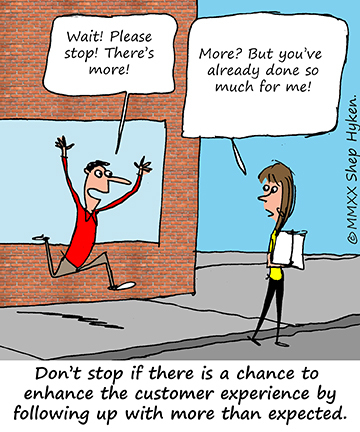 Much of my life is spent traveling. Lately, I’ve been home more than usual, along with most other people in the era of COVID-19.
Much of my life is spent traveling. Lately, I’ve been home more than usual, along with most other people in the era of COVID-19.
When I am home, I play hockey three or four times a week. This is hardcore cardio training with some friendly competition worked in, which makes for an exhilarating workout. Before we go further, you should know this isn’t a super-competitive league. We’re just out there to get some exercise and have fun. We all agree that we’re going to work the next day, so we agree to no physical contact, known in the game as “checking.” We just skate hard, pass a lot and occasionally score a goal. This all has a point, and here it is.
I was asked an interesting question in an interview about a lesson I learned from a personal experience, and my hockey experience is the perfect example. I notice that when a lot of my friends shoot the puck, they veer off to the side as if the play is finished, rather than to keep moving forward to see—assuming the goalie blocks the shot—if there’s going to be a rebound. That rebound gives you another shot at making a goal. Instead, they miss that opportunity.
What does this have to do with customer service and business? Let’s say you have a customer that is upset. You use your best customer service techniques to calm them down and resolve their problem. They go away happy. Is that it? Is that the end? What if you followed up the next day with a phone call, an email or a handwritten note? That’s the same as taking a great shot and following it up with a second shot.
Now, some of you might be thinking, “I took the metaphorical shot with the customer, and I scored. The customer is happy. Why do I have to follow the shot in?”
That’s the difference between the amateurs and the pros. The professionals take that extra step. They follow up, even when they don’t have to, because they know it’s that little extra effort that can be the difference between the customer saying, “They fixed the problem,” and “Wow, they sure know how to take care of their customers when there is a problem!” The latter doesn’t come from stopping when there is a possibility that there might be more you could do to enhance the customer experience.
This “follow the shot in” analogy can be used in many other areas of business. In the sales world, there are many reports about how many no’s you get from a customer before they say yes. What would have happened if Thomas Edison didn’t follow up after his first failure to invent a lightbulb? It’s said that he “followed that shot in” about 1,000 times before he had success.
The idea is simple: follow up. Maybe it’s doing something that isn’t expected. Don’t think it’s over until you give it more thought. In the game of hockey, you keep playing until that goal light goes on or the referee blows the whistle. So, keep playing and follow that shot in!
Shep Hyken is a customer service expert, keynote speaker, and New York Times bestselling business author. For information, contact 314-692-2200 or www.hyken.com. For information on The Customer Focus customer service training programs, go to www.thecustomerfocus.com. Follow on Twitter: @Hyken
customer service training programs, go to www.thecustomerfocus.com. Follow on Twitter: @Hyken
(Copyright © MMXX, Shep Hyken)
The post Following the Shot In appeared first on Shep Hyken.
September 22, 2020
Amazing Business Radio: Jerry Campbell

The Right Way to Measure Amazing Customer Service
How to Create an Empathetic, Omnichannel Service Experience
Shep Hyken interviews Jerry Campbell, Head of Customer Experience and Social Engagement at 7-Eleven. They discuss how to improve customer service in a rapidly changing digital world by focusing on human connection, diversity and inclusion.








Top Takeaways:
An omnichannel customer service experience is about being able to meet customers at any channel they choose and create a seamless experience for the customer between different channels.
The difference between omnichannel and multichannel is having all channels work together rather than simply having more than one channel available.
The transition between a chatbot or any AI technology should be seamless and invisible—the customer should not be able to tell when they’re talking to a bot versus an employee.
Many call centers focus on antiquated metrics that don’t ultimately best serve the customer. Focusing on resolving the customer’s issue the first time they call in (“first call resolution”) rather than reducing the average handle time can prove more cost-effective down the line.
More than anything, support center agents must be empathetic to the needs of the customer. Work from a place of wanting to solve the customer’s problem instead of meeting a financial metric.
Diversity, equality and inclusion (DEI) play a huge role both in support centers and in the overall customer experience. Not being able to connect with customers is a pain point. Call centers must be as diverse and inclusive as the customer base they serve.
Companies should create more self-service options for their customers, especially for common problems. Simply put, customers want this!
AI will never fully replace the human support agent. A bot will only get you so far before a human has to interject. A better solution is to integrate tech with your human employees to provide a better customer experience.
Quotes:
“Language barriers, gender barriers, anything that causes you not to be able to connect with a customer is a pain point. We must connect personally and with empathy to a wide range of customers.”
“Your call center is the front line for your company. If your call center is not diverse and inclusive, then you can’t meet the diverse culture of your customers.”
“How do you make something simple? You start with your process. If you don’t have your processes in place, it doesn’t matter how much technology you get. Tech without process just creates an automated mess.”
About:
Jerry Campbell is the Head of Customer Experience (CX) and Social Engagement at 7-Eleven, where he leads a team that delivers “world class” customer service and experience through an omnichannel approach.
Shep Hyken is a customer service and experience expert, New York Times bestselling author, award-winning keynote speaker, and your host of Amazing Business Radio.
The post Amazing Business Radio: Jerry Campbell appeared first on Shep Hyken.
September 21, 2020
5 Top Customer Service Articles For the Week of September 21, 2020
Each week I read a number of customer service and customer experience articles from various resources. Here are my top five picks from last week. I have added my comment about each article and would like to hear what you think too.
Customer Service Guide to Revenue Generation by Gladly
(Gladly) Turn your customer service department from a cost center into a revenue generator with these radically personal customer experience strategies from this guide.
My Comment: This is a special report from Gladly regarding the contact center’s role in delivering a great CX that gets customers to want to come back. You’ll have to download the report, and when you do you’ll get eight ideas on how to turn your customer support center into a revenue generator. And, who doesn’t want that!
Yaron Morgenstern: Digital Customer Experience Is All About the People by Sharon Florentine
(CMSWire) Yaron Morgenstern spoke with CMSWire about the ideal digital experience, why organizations need to look at the big picture first and the importance of focusing on outcomes.
My Comment: This is a fascinating article – actually an interview – featuring Yaron Morgenstern, the CEO OF Glassbox Digital. It covers his thoughts on the balance of digital and people, with a focus on functionality, usability and security.
3 Employee Experience Touchpoints That Impact Customer Experience by Jeannie Walters
(Experience Investigators) Employee experience has been called “the new customer experience” and “the answer to customer experience” in more than one article. There is no doubt the experience employees have, how engaged they are, and how well prepared they are has a direct impact on customer experience.
My Comment: I’ve always felt the focus on employees the way to create a better customer experience. This article focuses on three areas that you might not normally think of for your outside customers. I especially appreciate the first point, which is a focus on the first impression, which for employees starts at the “candidate experience.”
5 strategies for keeping customers happy and growing your business by Martin Zwilling, Inc
(Business Insider) If you are rolling out a new business, or focusing on a revamp for your existing one, here is a summary of the key elements I recommend, as a long-time business adviser, for a winning customer-centric strategy today.
My Comment: This is an excellent list of five ways to get your customers to come back. There are a couple of interesting points made. My favorite is number three, which is to dominate your industry before expanding to others. I’ve seen companies who want to diversify make the mistake of moving too quickly into a new industry before “perfecting” the one they are in.
5 Experiences That Define Strong Customer Service by Wise Marketer Staff
(The Wise Marketer) The level of competition in various industries constantly grows because customers have many options to choose from. The strong competition encourages companies from different niches to use artificial intelligence, cloud, and mobile technologies to provide valuable, personalized, and seamless customer experience.
My Comment: Want to meet – and even exceed – your customers’ expectations? Then read this article and pay attention to all five points. Simple ideas, yet powerful when executed well.
 Shep Hyken is a customer service expert, professional speaker and New York Times bestselling business author. For information on The Customer Focus
Shep Hyken is a customer service expert, professional speaker and New York Times bestselling business author. For information on The Customer Focus customer service training programs go to www.TheCustomerFocus.com. Follow on Twitter: @Hyken
customer service training programs go to www.TheCustomerFocus.com. Follow on Twitter: @Hyken
The post 5 Top Customer Service Articles For the Week of September 21, 2020 appeared first on Shep Hyken.
September 18, 2020
Guest Post: The Power of Visualizing and Sharing Customer Service Feedback Data
This week we feature an article by Elliott Sprecher, a marketing communications manager at JotForm . He writes about visualizing customer feedback in order to motivate your business to succeed.
There are thousands of articles about the importance of customer service to your business’s success. You can read just as many articles about the importance of customer feedback in operating your business successfully.
But there aren’t as many sources that tell you how to aggregate and distill that all-important customer service feedback to an entire organization — much less in a way that’s digestible and creates actionable insights.
In many cases, relaying information about customer service feedback comes in the form of “We need to do X, Y, and Z better,” or “People love our customer service; keep it up!”
In other words, it’s often only the high-level takeaways from customer service feedback that are communicated to your support team (if at all). And much of the time, that’s for good reason. You don’t want to inundate team members with survey data. After all, when faced a bunch of numbers on a scale chart, how likely is it that your eyes will gloss over?
That said, it’s important to give your support team the full picture when it comes to feedback—the good, the bad, and everything in between. Every piece of feedback can be a critical stepping stone to empowering your customer service team to succeed, which, in turn, will improve your customers’ experience. The trick is to disseminate that information in a way that allows your support team to absorb it holistically without feeling overwhelmed.
Data visualization isn’t a new concept, but it very well could be a new way for you to share customer feedback with your internal teams. Rather than simply listing the results of a customer service feedback survey in binary numbers on a sliding scale, demonstrating what those numbers look like in proportion to each other in a pie chart or a graph can be a much more effective way to communicate the data.
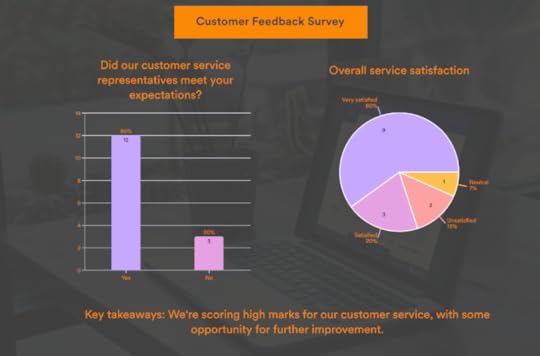
Visualizing data makes it more comprehensible and accessible — while accurately representing all of it. Instead of simply telling your team, “We’re doing pretty well with customer service,” you can show them just how well they’re doing.
And seeing the actual data can be a big motivator.
Of course, it’s important to take into account the kind of feedback you’re asking for. Most of the time, customer service feedback is as simple as “Were you happy with your service today?” or “Please rate your service on a scale from 1 to 5.”
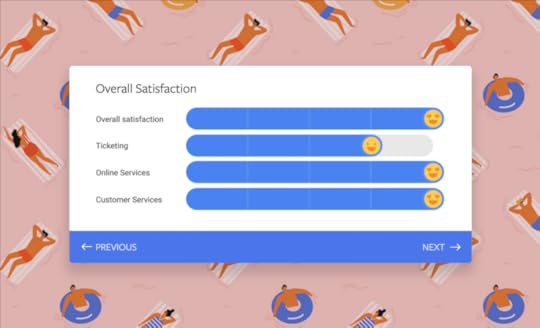
All this is well and good, but you may reap greater dividends by broadening your poll questions and grading customer satisfaction on a few more criteria or indicators. Though you shouldn’t include more than four or five questions, to avoid exhausting customers, the more questions you have and the more nuanced those questions, the better picture you’ll gain of your customer service success and the happiness of your customers as a whole. This can make relaying the data trickier, but using a convenient online tool can help.
The next time you conduct a customer service feedback poll — even if it’s as simple as “Were you happy with your service today?” — don’t stop when you have feedback that seems to show you’re on track, and leave it at that. Try presenting it in a way that visually tells the story behind the data. Then share it with your team. This is the result of their efforts, after all.
You might be surprised by the effect it has.
Elliott Sprecher is a marketing communications manager at JotForm. He informs organizations about the best ways to acquire and disseminate data to positively impact business.
F
 or more articles from Shep Hyken and his guest contributors go to customerserviceblog.com.
or more articles from Shep Hyken and his guest contributors go to customerserviceblog.com.
Read Shep’s latest Forbes article: Going Remote: When The Office Is Optional–Or Even Obsolete
The post Guest Post: The Power of Visualizing and Sharing Customer Service Feedback Data appeared first on Shep Hyken.
September 16, 2020
How Much Does It Cost to Give Great Customer Service?
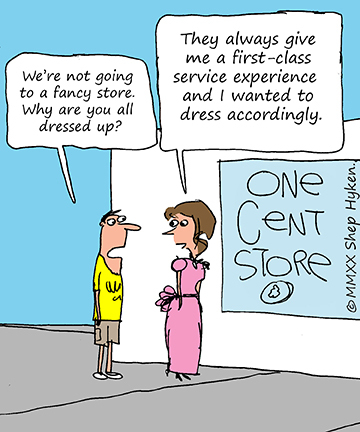 I recently wrote an article in Forbes about how to get customers to pay more. The focus, of course, was on customer service and experience.
I recently wrote an article in Forbes about how to get customers to pay more. The focus, of course, was on customer service and experience.
Research has irrefutably proven that customers will pay more for a better experience. Research also has irrefutably proven that customers will leave you for your competition if you don’t give them the service they expect.
One of my Forbes readers, Daniel Rodriguez, sent in an interesting comment. He said, “What’s interesting is that better service is correlated to a higher willingness for the customer to pay, but that doesn’t mean that a business has to spend more on CS to get these results.”
This reminds me of something my good friend, Kim Tucci, used to say: “It doesn’t cost much more to go first class.” He wasn’t talking about upgrading a coach seat on a plane to a first-class seat. He was talking about how, in general, doing right, in a classier manner, doesn’t usually cost much more, if anything at all. It’s the same for certain aspects of customer service.
First, the department that is often referred to as “customer service” should not be viewed as a cost center. Done right, it is what makes your company profitable. Customer service representatives save customers that are unhappy and, in many cases, ensure customers come back. Yes, there are overhead costs associated with their salaries and the equipment and technology they use. But when they do it right, it doesn’t cost. It pays. Doing it right doesn’t have to cost extra beyond the obvious costs just mentioned. To get you started with this line of thinking, here are a few ways to do it right that won’t cost much at all—at least compared to the results you gain.
Do it right the first time, as in taking care of the customer so they don’t have to call back and start over. One call with a customer, even if it takes a little more time, costs less than two—or three or four or even more!
Be nice. This was the topic of a recent Shepard Letter. It doesn’t cost extra to be nice, but it can pay huge dividends. I know… this is common sense. Unfortunately, it’s not always so common.
Grant authority to employees to make customer-focused decisions. This is about giving your team the authority to take care of your customers. It takes some training to show an employee how far they can go, but once you train them, let them go forth and be successful. Customers love dealing with people who can make decisions. This can be summed up in one word: empowerment.
None of these ideas cost much at all. As a matter of fact, doing it right the first time saves you money. Being nice doesn’t cost anything. Empowering employees does cost a little, as you have to train people what they can do and how far they can go, but the payoff is big. In the end, how much does it cost to give great customer service? Not that much!
Shep Hyken is a customer service expert, keynote speaker, and New York Times bestselling business author. For information, contact 314-692-2200 or www.hyken.com. For information on The Customer Focus customer service training programs, go to www.thecustomerfocus.com. Follow on Twitter: @Hyken
customer service training programs, go to www.thecustomerfocus.com. Follow on Twitter: @Hyken
(Copyright © MMXX, Shep Hyken)
The post How Much Does It Cost to Give Great Customer Service? appeared first on Shep Hyken.
September 15, 2020
Amazing Business Radio: Geoff Webb
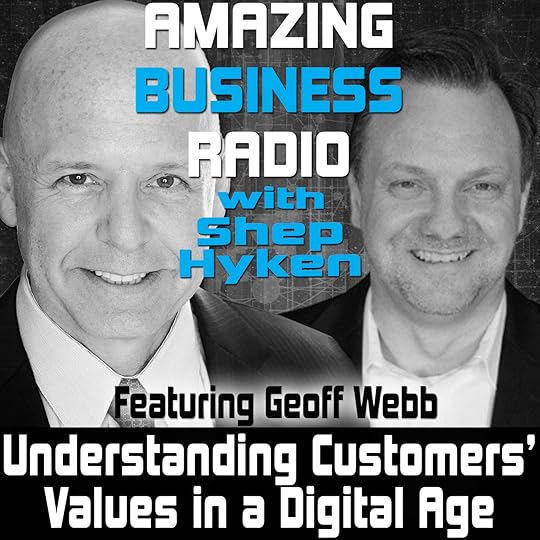
Understanding Customers’ Values in a Digital Age
How AI and Human Partnership Can Create a Better Customer Experience
Shep Hyken interviews Geoff Webb, the Vice President of Products at PROS. They discuss how automation can eliminate friction and create a better buying and selling experience for customers in a new digital age.








Top Takeaways:
There must be a balance between artificial intelligence (AI) and human connection. As with any new technology, there always needs to be a human fallback.
The COVID-19 pandemic resulted in a massive shift in both business and consumer buying preferences and habits. Many companies were unprepared to make the shift to e-commerce, self-service and other digital channels.
Think of AI instead as IA, or intelligent assistant. Have it support an employee (versus a customer) so they have faster access to the right information. This helps them work more efficiently to support the customer, which results in a better customer experience.
The role of the salesperson is shifting to that of an expert. Consumers (in both B2B and B2C) expect to be able to turn to sales reps for information and answers.
When a consumer knows they can rely on a sales rep or vendor for the fastest, most accurate information, it can drive customer loyalty. Customers will continue to come back because they know they can rely on that company to give them what they need.
In B2B buying, the stakes are incredibly high. Any friction or errors within this sales process could have long-lasting repercussions, costing you not only millions of dollars but even the customer.
Omnichannel solutions can help eliminate friction for both customers and employees. The channels must be easy to use and seamless to switch between.
Companies need to talk to their customers on a much deeper level to understand their new wants, needs and values in reaction to a rapidly changing world. They must also find new ways to create that personalized experience.
Quotes:
“Bringing together the analytic power of AI and the context and empathy power of a human being can deliver an incredibly personalized, really effective, fast selling process.”
“The concept of omnichannel, of moving between channels seamlessly and very easily, is what really transforms the sales process.”
“Friction in the sales process is something that will eventually drive even a good customer away. Nobody wants that.”
“If you can give your customer exactly the right thing they need because you truly know them, they often don’t mind paying a little more for that. Creating that level of personalization in every instance has huge value. Businesses need to ask themselves how to make that happen.”
About:
Geoff Webb is the Vice President of Products at PROS, where he works with technology, marketing and go-to-market teams. He has over 25 years of experience in the technology industry in addition to sales and marketing management.
Shep Hyken is a customer service and experience expert, New York Times bestselling author, award-winning keynote speaker, and your host of Amazing Business Radio.
The post Amazing Business Radio: Geoff Webb appeared first on Shep Hyken.
September 14, 2020
5 Top Customer Service Articles For the Week of September 14, 2020
Each week I read a number of customer service and customer experience articles from various resources. Here are my top five picks from last week. I have added my comment about each article and would like to hear what you think too.
12 Ways to Celebrate Customer Service Week by Vanessa Brangwyn
(Achievers) Above all, Customer Service Week is an opportunity to stop and think about the interconnected well-being of all the people who make up your business: the ones who use your product or service and the ones who serve your customers and help make your organization run seamlessly.
My Comment: We start this week’s Roundup with a reminder of the upcoming Customer Service Week, which is the first full week of October every year (October 5-9, 2020). While many people think this is a celebration about our customers, it is just as much a celebration about our people who take care of our customers. What are you planning for this special and important week? Here are a few ideas.
How to Boost B2B Customer Experience on Your Website by Chris Christoff
(Business2Community) This article shares some of the most effective tips on how to boost B2B customer experience on your website.
My Comment: Your website is a powerful opportunity to deliver a better customer experience. I like that this article focuses on B2B, but the same ideas can be applied to the B2C online experience. Pay attention to numbers two and three, which are about streamlining the buying process (making it more convenient) and using more video on t
Customer and Employee Criticism: Your Leverage Tool for Growth by Ricardo Saltz Gulko
(Eglobalis) People are busy. If they are taking the time to criticize something, you need to make sure you are listening. There are four initial potential cases that can generate criticism from customers:
My Comment: I recently featured an article on criticism in the weekly Top Five roundup. Here’s another, and it takes the topic to a deeper level. There is some information about NPS (Net Promoter Score) that could make for an interesting discussion (debate), and I also appreciate how the author gave us reasons that generate criticism from customers beyond frustration.
Adaptability- A Key Skill in the Covid Era by Garima Patet
(LearningNotes) The year 2020 is the year of those individuals who are successfully adapting themselves to the chaos incurring due to these tumultuous times. The good news is that the skill of Adaptability can be cultivated and learned.
My Comment: I love the concept of adaptability. In our training programs, we talk about the concept as it relates to adapting to your customer’s behavioral style and personality. This article moves to the concept of adapting to what must be done during the COVID-19 pandemic. Other words to describe this might be flexibility or pivoting. The point is that the way we do business today is different from just six months ago, and it’s important to adapt.
Call Centers Are Out Experience Centers Are In by NobelBiz
(NobelBiz) Our eBook will take an in-depth look at how trending consumer preferences are actively influencing the contact center space. Because we live in this space and we’re also the people behind it.
My Comment: We wrap this week’s roundup with a report you’ll have to download to read. It’s a short ebook on turning the call center into an experience center. Imagine that! Idea number one is that support should be a pleasure. Take a quick read through this short ebook and start thinking in terms of experience versus customer support.
 Shep Hyken is a customer service expert, professional speaker and New York Times bestselling business author. For information on The Customer Focus
Shep Hyken is a customer service expert, professional speaker and New York Times bestselling business author. For information on The Customer Focus customer service training programs go to www.TheCustomerFocus.com. Follow on Twitter: @Hyken
customer service training programs go to www.TheCustomerFocus.com. Follow on Twitter: @Hyken
The post 5 Top Customer Service Articles For the Week of September 14, 2020 appeared first on Shep Hyken.
September 11, 2020
Guest Post: The Future of Customer Experience–Create an Offer People Can’t Refuse
This week we feature an article by Steven Van Belleghem, author, entrepreneur and international keynote speaker . He provides tips and insight on the future of your business and your customers’ expectations.
This is a turning point.
The world is at a turning point. Not just because of COVID-19. The pandemic merely accelerated a number of trends that were already emerging. The turning point affects different social layers as well.
First of all, the digital world is growing faster than ever. This is the end of digital versus analog, of online versus offline. We are now entering a hybrid world where almost every aspect of our lives will include a digital component. This evolution has a huge impact on the interactions between companies and customers.
Secondly, the attitude of the world is changing. People see the challenges the world is facing. Healthcare, climate and inequality are just a few of the serious problems we need to solve. People react differently to these challenges. Some people are afraid of them, others try to meet them and some even try to ignore them. This is the time for your organization to stand up. When it comes to dealing with global challenges, people tend to place more trust in companies than in governments. Companies have the resources and the ability to make a difference. In my new book, The Offer You Can’t Refuse, I invite companies to think about the changes they can affect in THEIR world. It’s not about changing the world, it’s about changing YOUR world. What is the good versus the bad in your market? And once you understand that trade-off, how can you reduce or maybe even eliminate it?
New Customer Behavior
The behavior of customers is changing constantly. Today, many companies are asking themselves what changes in behavior because of COVID-19 will be permanent versus only temporary? My advice is to look at the long-term behaviors. To understand the future changes in customer behavior, I advise companies to look at the following evolutions.
The new customer expectations are influenced by three elements:
General Purpose T echnology : The coming decade will see the growth of technologies such as 5G, artificial intelligence, quantum computing and robotics. Each of these technologies has the potential to change whole industries. But the combination of the four technologies together is set to revolutionize the way we live and work. The technologies will also offer new possibilities to take customer relations to a higher level.
Personal Challenges : Everyone has their own personal dreams, fears, wishes and ambitions. As digital ease of use becomes the new norm, the question for companies will be how they can make the difference by responding successfully to the more emotional aspects of their customers’ lives. Digital ease of use will guarantee transactional convenience. The next step is to provide greater ease and convenience for customers’ emotional expectations.
Societal Challenges : More and more people are asking questions about the future of society. Challenges relating to technology, health and the climate are now at the top of many people’s agendas. As a company, you can make use of your strengths to create a positive added value for the community.
How to Create an ‘Offer They Can’t Refuse’
In order to win the heart and the business of customers, it is advisable to take these evolutions into account. In my new book, The Offer You Can’t Refuse, I have developed a customer experience model that can help you to create a future proof approach.
You can develop The Offer You Can’t Refuse by investing in the following four axes, which will allow you to react in an appropriate manner to the new generation of customer expectations:
Good Product, Service and Price : This is of course obvious. It is the minimum layer to win the business of your customers.
Ultimate Convenience : This is the use of new technology in a smart way to make interfaces ever more automated, so that the customer needs to make no effort to do business with your company. This leads to the perfect transactional relationship.
Partner in Life : This is not about your customer journey, but about the life journey of your customer. Which aspects in the lives of your customers create negative or positive energy? What things cost them too much effort? If you can provide answers to these questions, you can optimize your emotional relationship with your customers.
Save Your World : This is about companies taking their responsibility to do good for society as a whole. Every company has strengths that it can use to create a societal added value. Search for concrete solutions and contributions that will allow your company to make a truly tangible impact.
Steven Van Belleghem is an author, entrepreneur and international keynote speaker. His core expertise is the future of customer-centricity. The combination between customer-centric thinking, the latest technologies and the human touch is the guiding principle in Steven’s stories.
F
 or more articles from Shep Hyken and his guest contributors go to customerserviceblog.com.
or more articles from Shep Hyken and his guest contributors go to customerserviceblog.com.
Read Shep’s latest Forbes article: Key To Uncertain Times: Create Customer Confidence
The post Guest Post: The Future of Customer Experience–Create an Offer People Can’t Refuse appeared first on Shep Hyken.









